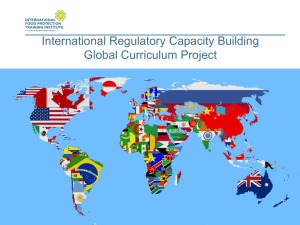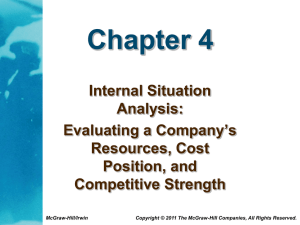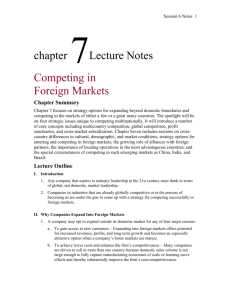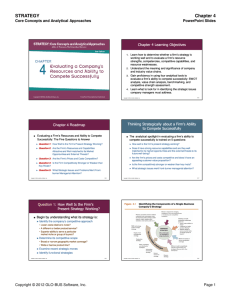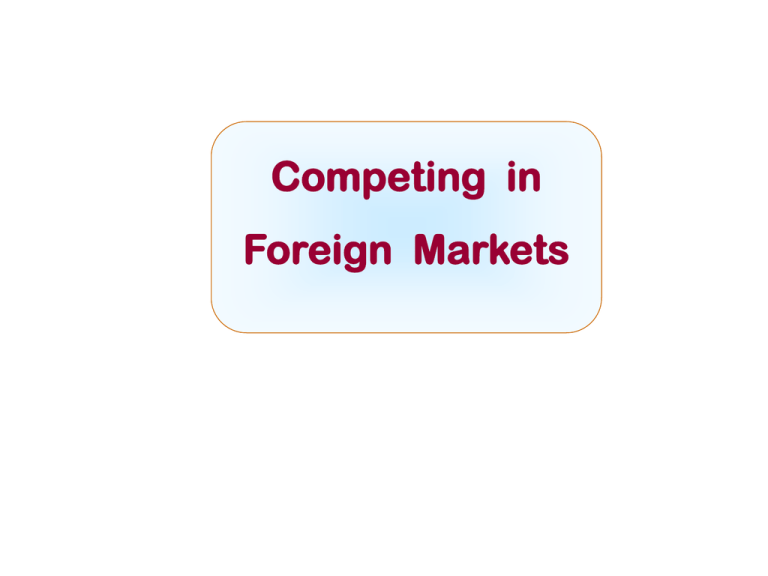
Competing in
Foreign Markets
McGraw-Hill/Irwin
Copyright © 2008 by The McGraw-Hill Companies, Inc. All rights reserved.
“You have no choice but to
operate in a world shaped
by globalization and the
information revolution.
There are two options:
Adapt or die.”
Andrew S. Grove
The Four Big Strategic Issues
in Competing Multinationally
• Whether to customize a company’s offerings in each different
country market to match preferences of local buyers or offer a
mostly standardized product worldwide
• Whether to employ essentially the same
basic competitive strategy in all countries
or modify the strategy country by country
• Where to locate a company’s production facilities,
distribution centers, and customer service operations
to realize the greatest locational advantages
• How to efficiently transfer a company’s resource strengths and
capabilities from one country to another to secure competitive
advantage
Why Do Companies Expand
into Foreign Markets?
Gain access to
new customers
Obtain access to
valuable natural
resources
Achieve lower
costs and enhance
competitiveness
Spread
Capitalize
business risk across
on core
wider
competencies
market base
International vs. Global Competition
International
Competitor
Company operates in a select
few foreign countries, with
modest ambitions to expand
further
Global
Competitor
Company markets products in
50 to 100 countries and
is expanding operations into
additional country markets
annually
How Markets Differ from
Country to Country
• Economy
• Legal/political
• Regulatory
• Technology
• Socio-cultural
• Demographic
CIA World Fact Book
Two Primary Patterns
of International Competition
Multi-country
Competition
Global Competition
Characteristics of
Multi-Country Competition
• Market contest among rivals in one country
not closely connected to market contests in
other countries
• Buyers in different countries are
attracted to different product attributes
• Sellers vary from country to country
• Industry conditions and competitive forces in
each national market differ in important
respects
Rival firms battle for national championships –
winning in one country does not necessarily signal the ability
to fare well in other countries!
Characteristics of Global Competition
• Competitive conditions across
country markets are strongly linked
– Many of same rivals compete in
many of the same country markets
– A true international market exists
• A firm’s competitive position in one country is
affected by its position in other countries
• Competitive advantage is based on a firm’s worldwide operations
overall global
standing
Rival firmsand
in globally
competitive
industries vie for worldwide leadership!
Strategy Options for
Competing in Foreign Markets
• Exporting
• Licensing
• Franchising strategy
• Multi-country strategy
• Global strategy
• Strategic alliances or joint ventures
Localized Multicountry Strategies
or a Global Strategy?
Strategic Issue
• Whether to vary a company’s competitive
approach to fit specific market conditions and
buyer preferences in each host county
OR
• Whether to employ essentially the same strategy
in all countries
Characteristics of a “Think-Local,
Act-Local” Approach to Strategy Making
• Business approaches are deliberately crafted to
– Accommodate differing tastes and expectations of buyers
in each country
– Stake out the most attractive market positions vis-à-vis
local competitors
• Local managers are given considerable
strategy-making latitude
• Plants produce different products
for different local markets
• Marketing and distribution are adapted
to fit local customs and cultures
Characteristics of a “Think-Global,
Act-Global” Approach to Strategy Making
• Same products under the same brand names are sold everywhere
• Same distribution channels are used in all countries
• Competition is based on the same capabilities
and marketing approaches worldwide
• Strategic moves are integrated and coordinated worldwide
• Expansion occurs in most nations where significant buyer demand
exists
• Strategic emphasis is placed on building
a global brand name
• Opportunities to transfer ideas, new
products, and capabilities from one
country to another are aggressively pursued
Your Opinion
Assume you are in charge of developing the strategy for a multinational
company selling products in several different countries around the world.
A. If your company’s product is personal computers, do you think it would
make better strategic sense to employ a multicountry strategy or a global
strategy? Why?
B. If your company’s product is dry soup mixes and canned soups, would a
multicountry strategy seem to be more advisable than a global strategy?
Why?
C. If your company’s product is washing machines, would it seem to make
more sense to pursue a multicountry strategy or a global strategy? Why?
D. If your company’s product is basic work tools (hammers, screwdrivers,
pliers, wrenches, saws), would a multicountry strategy or a global strategy
seem to have more appeal? Why?
Building Competitive
Advantage in Foreign Markets
• Three ways to gain competitive advantage
1. Locating activities among nations in ways that lower
costs or achieve greater product differentiation
2. Efficient/effective transfer of competitively
valuable competencies and capabilities from
company operations in one country to
company operations in another country
3. Coordinating dispersed activities in
ways a domestic-only competitor cannot
Locating Activities to Build a
Global Competitive Advantage
• Two issues
– Whether to
• Concentrate each activity in a
few countries or
• Disperse activities to many
different nations
– Where to locate activities
• Which country is best
location for which activity?
Transferring Valuable Competencies to Build a
Global Competitive Advantage
• Transferring competencies, capabilities, and resource
strengths across borders contributes to
– Development of broader competencies and capabilities
– Achievement of dominating depth in some competitively
valuable area
• Dominating depth in a competitively valuable
capability is a strong basis for sustainable competitive
advantage over
– Other multinational or global competitors and
– Small domestic competitors in host countries
What Are Profit Sanctuaries?
• Profit sanctuaries are country
markets where a firm
– Has a strong, protected market
position and
– Derives substantial profits
• Generally, a firm’s most strategically
crucialProfit
profitsanctuaries
sanctuary isare
its ahome
market
valuable
competitive asset in global industries!
What Is Cross-Market Subsidization?
• Involves supporting competitive offensives in one market with
resources/profits diverted from operations in other markets
• Competitive power of cross-market subsidization results from
a global firm’s ability to
– Draw upon its resources and profits in other country markets to
mount an attack on single-market or one-country rivals and
– Try to lure away their customers with
•
•
•
•
Lower prices
Discount promotions
Heavy advertising
Other offensive tactics
Global Strategic Offensives
Three Options
• Attack a foreign rival’s profit sanctuaries
– Approach places a rival on the defensive, forcing it to
•
•
•
•
Spend more on marketing/advertising
Trim its prices
Boost product innovation efforts
Take actions raising its costs and eroding its profits
• Employ cross-market subsidization
– Attractive offensive strategy for companies competing in multiple country
markets with multiple products
• Dump goods at cut-rate prices
– Approach involves a company selling goods in foreign markets at prices
• Well below prices at which it sells in its home market or
• Well below its full costs per unit
SIC Codes
EU
MERCOSUR
WTO
Strategic Appeal of Strategic Alliances
• Gain better access to attractive country markets from host
country’s government to import and market products locally
• Capture economies of scale in production and/or marketing
• Fill gaps in technical expertise or knowledge of local markets
• Share distribution facilities and dealer networks
• Direct combined competitive energies
toward defeating mutual rivals
• Take advantage of partner’s local market
knowledge and working relationships with
key government officials in host country
• Useful way to gain agreement on
important technical standards
Characteristics of Competing
in Emerging Foreign Markets
• Tailoring products for big, emerging markets
often involves
– Making more than minor product changes and
– Becoming more familiar with local cultures
• Companies have to attract buyers with
bargain prices as well as better products
• Specially designed and/or specially
packaged products may be needed to
accommodate local market circumstances
• Management team must usually consist
of a mix of expatriate and local managers
Strategic Options: How to Compete
in Emerging Country Markets
• Prepare to compete on the basis of low price
• Be prepared to modify aspects of
the company’s business model to
accommodate local circumstances
• Try to change the local market to better match the way
the company does business elsewhere
• Stay away from those emerging markets where it is
impractical or uneconomic to modify the company’s
business model to accommodate local circumstances
Strategic Options to Defend Against Global Giants
• Use home field advantage
• Transfer expertise
• Shift business model
• Go global
Econet




